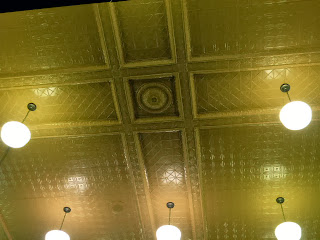Are we the only people in America who didn't know this gem was here. Known for the Christmas Festival of Lights - which we stumbled upon was just beginning to come to life, the city park and river-walk, along the Cane River, in the historic district is beautiful, quiet and just steps away from the many shops, cafes and historic colonial era homes that line the shore.
 A short walk from downtown you can see this Prudhomme Rouquier house which belongs to the family that also owned the Oakland Plantation just a few miles away - now Cane River Creole National Historic Park. Est. in 1821 it continued to be occupied by the Prudhomme family until 1998, at which time it was turned over to the NPS
A short walk from downtown you can see this Prudhomme Rouquier house which belongs to the family that also owned the Oakland Plantation just a few miles away - now Cane River Creole National Historic Park. Est. in 1821 it continued to be occupied by the Prudhomme family until 1998, at which time it was turned over to the NPS 
and is now the Cane River Creole NHP.
The plantation is almost completely intact as it appeared in the mid 1850's with just one or two changes. The cook's cabin was moved, in the 1930's to another part of the property for use as a hunter's lodge; and the main house has been restored back to the 1960's era - considered the end of the "sharecropping era".
This 3 sash window section, is not only in-line  with the front gate, but the 2 lower sections move up to allow for an additional 'entry/exit' into the main house. One on each side of the front door provided additional air flow during warmer months.
with the front gate, but the 2 lower sections move up to allow for an additional 'entry/exit' into the main house. One on each side of the front door provided additional air flow during warmer months.
 with the front gate, but the 2 lower sections move up to allow for an additional 'entry/exit' into the main house. One on each side of the front door provided additional air flow during warmer months.
with the front gate, but the 2 lower sections move up to allow for an additional 'entry/exit' into the main house. One on each side of the front door provided additional air flow during warmer months.
The 3,000 bottle garden below, begun prior to the Civil War, was both an early method of recycling of used French wine bottles and a method of replacing the box hedges that lined each segment of the garden.
After the Civil War, plantations created their own farm stores for supplies; both for the owners use, but also for their sharecroppers.

Tokens like these were used to pay the sharecroppers, hence forcing them to also spend them in the plantation 'store'.
If you happen to find yourself in Natchitoches like us...do yourself a huge favor and to Lasyones for one of their famous, hand-made meat pies. (They also have a crawfish pie, for those who are meat-free.) It could become an addiction...
Before I take you further down the road...just a whimsical last note on plantation life. Ever wonder where the phrase "shoo fly" came from? Pre-Civil War house dining rooms were equipped with a wooden panel bolted to the ceiling, and a young slave sitting on the floor would swing it back-forth, thus creating a breeze to "shoo flies away"from the dining guests.
A short walk down main street one will find the
Built to stop the expansion of the Spanish from Texas, it served as a trade center first for the tobacco crops and then later cotton.At the fort, which is pretty much self-guided, there are roving "en-actors", dressed in period costumes, who will answer questions about the creation of, and function of the fort during it's usage. Mike asked the young man with the long gun about it's workings and he was more than happy to explain and demonstrate how to prime, load and fire the rifle. Had I known we would get a live demo I would have taken a video of it...so wish I had that now.
Walking back to the forts visitor's center this is the view from along the water's edge.
I have compiled a slide show attached to the blog should you wish to see more of Natchitoches, Oakland Plantation and Fort St. Jean Baptiste.
~ Ciao



















































